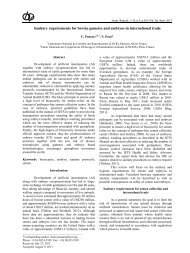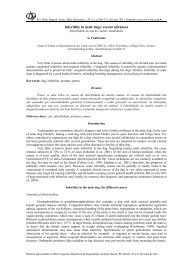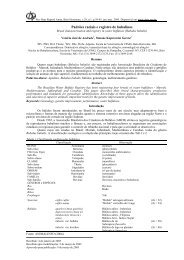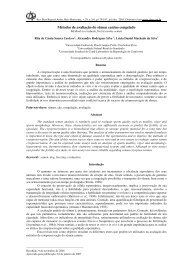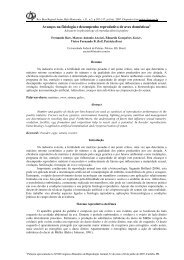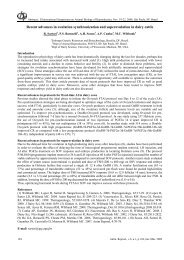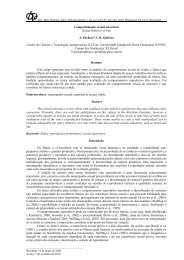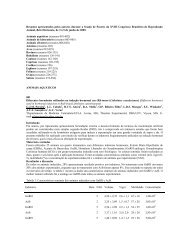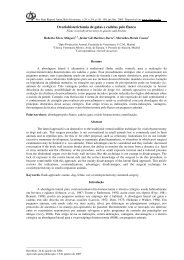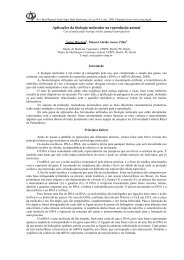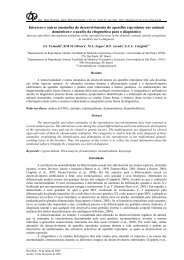Endocrine control of ovarian function in dogs and other carnivores
Endocrine control of ovarian function in dogs and other carnivores
Endocrine control of ovarian function in dogs and other carnivores
Create successful ePaper yourself
Turn your PDF publications into a flip-book with our unique Google optimized e-Paper software.
Concannon et al. Ovarian <strong>function</strong> <strong>in</strong> <strong>dogs</strong> <strong>and</strong> <strong>other</strong> <strong>carnivores</strong>.<br />
species (lions, tigers, jaguars, leopards). The importance <strong>of</strong><br />
the dog as a model species is evidenced by the support <strong>and</strong><br />
success <strong>of</strong> the can<strong>in</strong>e genome project f<strong>in</strong>ancially supported<br />
by the National Institutes <strong>of</strong> Health; furthermore, there are<br />
36 species <strong>in</strong> the family Canidae <strong>of</strong> which n<strong>in</strong>e are<br />
formally listed as threatened or endangered by ext<strong>in</strong>ction<br />
(see Songasassen <strong>and</strong> Wildt, 2002)<br />
Can<strong>in</strong>e <strong>ovarian</strong> cycle <strong>and</strong> pregnancy<br />
The <strong>ovarian</strong> cycle <strong>and</strong> pregnancy <strong>of</strong> the<br />
domestic dog (C. lupus familiaris) are not only<br />
prototypical <strong>of</strong> those <strong>of</strong> <strong>other</strong> canids <strong>and</strong> most<br />
<strong>carnivores</strong> but also likely exemplify to a large extent the<br />
<strong>ovarian</strong> activity <strong>and</strong> pregnancies <strong>in</strong>volved <strong>in</strong> the very<br />
early evolution <strong>of</strong> placental mammals. Domestic <strong>dogs</strong><br />
are monestrous, non-seasonal spontaneous ovulators<br />
with spontaneous luteal <strong>function</strong> <strong>and</strong> pronounced<br />
progesterone secretion that lasts from 55 to 75 days,<br />
average 65 days, <strong>and</strong> approximately the 2-month<br />
duration <strong>of</strong> pregnancy (Fig. 1 <strong>and</strong> 2). Thus the CL <strong>of</strong> the<br />
cycle are <strong>in</strong> most <strong>in</strong>stances sufficient to support a term<br />
pregnancy absent support or supplementation by any<br />
pregnancy specific mechanisms – a phenomenon critical<br />
<strong>in</strong> a species that has no placental progesterone<br />
production or placental gonadotroph<strong>in</strong>, <strong>and</strong> a scenario<br />
likely present early <strong>in</strong> mammalian evolution. This<br />
physiological pseudo-pregnancy follow<strong>in</strong>g ovulation is<br />
seen <strong>in</strong> all <strong>carnivores</strong> studied, either follow<strong>in</strong>g<br />
spontaneous ovulation, or follow<strong>in</strong>g <strong>in</strong>fertile mat<strong>in</strong>g <strong>in</strong><br />
<strong>in</strong>duced ovulators. It is also comparable to the<br />
prolonged luteal phases <strong>of</strong> hysterectomized <strong>in</strong>dividuals<br />
<strong>in</strong> species that have an acute uter<strong>in</strong>e luteolytic<br />
mechanism (Fig 3). Although <strong>dogs</strong> evolved from a<br />
photoperiod-entra<strong>in</strong>ed seasonal breeder, the primitive<br />
wolf, their non-seasonal breed<strong>in</strong>g pattern is potentially<br />
similar to the pattern <strong>of</strong> the progenitor to the orig<strong>in</strong>al<br />
<strong>carnivores</strong>. Inter-estrus <strong>in</strong>tervals <strong>in</strong> <strong>dogs</strong> range from 5 to<br />
13 months, average about 7 months <strong>in</strong> most breeds, <strong>and</strong><br />
potentially parallel an endogenous circannual cycle. The<br />
pre-ovulatory LH surge <strong>and</strong> ovulation 2 days later occur<br />
after a 1-3 week (average 9 day) period <strong>of</strong> proestrus.<br />
Proestrus is characterized by progressive <strong>and</strong> eventual<br />
full cornification <strong>of</strong> the vag<strong>in</strong>al epithelium,<br />
serosangu<strong>in</strong>ous discharge <strong>of</strong> fluid <strong>and</strong> erythrocytes<br />
orig<strong>in</strong>at<strong>in</strong>g by diapedesis through the uter<strong>in</strong>e capillaries,<br />
pheromonal secretion caus<strong>in</strong>g <strong>in</strong>creased attraction <strong>of</strong><br />
males, <strong>and</strong> progressive <strong>and</strong> anatomically visible edema<br />
<strong>and</strong> turgor <strong>of</strong> the vulva <strong>and</strong> vag<strong>in</strong>al stroma. All are<br />
effects <strong>of</strong> ris<strong>in</strong>g estradiol concentrations. Estrus is<br />
concomitant with subsequently decl<strong>in</strong><strong>in</strong>g phase <strong>of</strong> estradiol<br />
concentrations. Estrus beg<strong>in</strong>s typically 0-1 days after the<br />
LH surge <strong>and</strong> behaviorally lasts an average <strong>of</strong> 7 days.<br />
Cl<strong>in</strong>ical or morphological "estrus" is <strong>of</strong>ten def<strong>in</strong>ed as<br />
end<strong>in</strong>g when the vag<strong>in</strong>al smears previously characteristic<br />
<strong>of</strong> estrus are no longer predom<strong>in</strong>antly cornified (range days<br />
6-11, average 7.5), with the rem<strong>in</strong>der <strong>of</strong> the luteal be<strong>in</strong>g<br />
historically termed metestrus <strong>and</strong> more recently diestrus.<br />
Corroboration is also obta<strong>in</strong>ed cl<strong>in</strong>ically based on the<br />
day that the wr<strong>in</strong>kl<strong>in</strong>g <strong>and</strong> sacculation <strong>of</strong> previously<br />
smooth edematous <strong>and</strong> cornified vag<strong>in</strong>al mucosal folds<br />
produced dur<strong>in</strong>g proestrus ends with folds become<br />
visibly less pronounced <strong>and</strong> appear<strong>in</strong>g more flat <strong>and</strong><br />
obviously less white (less cornified) with submucosal<br />
capillaries aga<strong>in</strong> visible as they were prior to the vag<strong>in</strong>al<br />
growth <strong>of</strong> proestrus - end<strong>in</strong>g typically at 7-9 days after the<br />
LH surge.<br />
Days fom LH surge<br />
Figure 1. Schematic diagram <strong>of</strong> changes <strong>in</strong> circulat<strong>in</strong>g estradiol, LH, progesterone <strong>and</strong> prolact<strong>in</strong> concentrations<br />
dur<strong>in</strong>g pregnancy <strong>in</strong> <strong>dogs</strong>. More recent studies have demonstrated an even more pronounced pregnancy specific rise<br />
<strong>in</strong> prolact<strong>in</strong> beg<strong>in</strong>n<strong>in</strong>g at day 25-30 <strong>of</strong> pregnancy.<br />
Anim. Reprod., v.6, n.1, p.172-193, Jan./Mar. 2009 173



